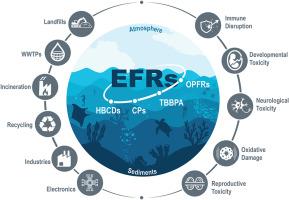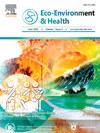海洋环境中新出现的阻燃剂:发生、命运和分析挑战的全面回顾
IF 17.6
引用次数: 0
摘要
新兴阻燃剂(EFR)由于其广泛的应用、持久性和远距离大气迁移能力,在海洋环境中无处不在。由于在复杂基质中固有的低灵敏度和选择性、基质诱导的信号抑制、有限的分析通量以及缺乏可靠的非靶点筛选方案,海洋基质中efr的准确分析仍然具有挑战性。本文综述了最近在方法上的突破,包括灵敏的仪器方法和创新的提取和纯化技术,用于海洋多基质中EFR检测。EFRs的环境发生和过程表明,颗粒介导的运输、塑料碎片的浸出和光化学降解共同支配着EFRs在海洋环境中的命运。此外,该综述还严格审查了efr的生态风险,重点关注其生物积累驱动的毒性、海洋食物网的营养放大以及生态系统不稳定的可能性。总结了光化学转化途径的机理,强调了持久性和毒性更强的产物的形成,这些产物增加了海洋环境中长期暴露和生态破坏的风险。它为监管机构评估海洋环境风险和实施有针对性的缓解战略提供了科学基础。未来的研究应侧重于量化efr的生态影响,以支持更有效的监测和管理框架。本文章由计算机程序翻译,如有差异,请以英文原文为准。

Emerging flame retardants in the marine environment: A comprehensive review of occurrence, fate and analytical challenges
Emerging flame retardant (EFR) pollutants are ubiquitous in marine environment due to their extensive applications, and capacity for persistence and long-range atmospheric transport. The accurate analysis of EFRs in marine matrices remains challenging due to the inherently low sensitivity and selectivity in complex matrices, matrix-induced signal suppression, limited analytical throughput, and the lack of robust non-target screening protocols. This review provides an integration of recent methodological breakthroughs, encompassing sensitive instrumental approaches and innovative extraction and purification techniques for EFR detection in marine multi-matrix. The environmental occurrence and process of EFRs highlight that the roles of particle-mediated transport, plastic debris leaching, and photochemical degradation co-govern the fate of EFRs in marine environments. Furthermore, the review critically examines the ecological risks of EFRs, focusing on their bioaccumulation-driven toxicity, trophic magnification in marine food webs, and the potential for ecosystem destabilization. Mechanistic insights into photochemical transformation pathways are summarized, highlighting the formation of persistent and more toxic products that raise risks of chronic exposure and ecological disruption in marine environment. It provides a scientific foundation for regulatory agencies to assess marine environmental risks and implement targeted mitigation strategies. Future research should focus on quantifying the ecological impacts of EFRs to support a more effective monitoring and management framework.
求助全文
通过发布文献求助,成功后即可免费获取论文全文。
去求助
来源期刊

Eco-Environment & Health
环境科学与生态学-生态、环境与健康
CiteScore
11.00
自引率
0.00%
发文量
18
审稿时长
22 days
期刊介绍:
Eco-Environment & Health (EEH) is an international and multidisciplinary peer-reviewed journal designed for publications on the frontiers of the ecology, environment and health as well as their related disciplines. EEH focuses on the concept of “One Health” to promote green and sustainable development, dealing with the interactions among ecology, environment and health, and the underlying mechanisms and interventions. Our mission is to be one of the most important flagship journals in the field of environmental health.
Scopes
EEH covers a variety of research areas, including but not limited to ecology and biodiversity conservation, environmental behaviors and bioprocesses of emerging contaminants, human exposure and health effects, and evaluation, management and regulation of environmental risks. The key topics of EEH include:
1) Ecology and Biodiversity Conservation
Biodiversity
Ecological restoration
Ecological safety
Protected area
2) Environmental and Biological Fate of Emerging Contaminants
Environmental behaviors
Environmental processes
Environmental microbiology
3) Human Exposure and Health Effects
Environmental toxicology
Environmental epidemiology
Environmental health risk
Food safety
4) Evaluation, Management and Regulation of Environmental Risks
Chemical safety
Environmental policy
Health policy
Health economics
Environmental remediation
 求助内容:
求助内容: 应助结果提醒方式:
应助结果提醒方式:


